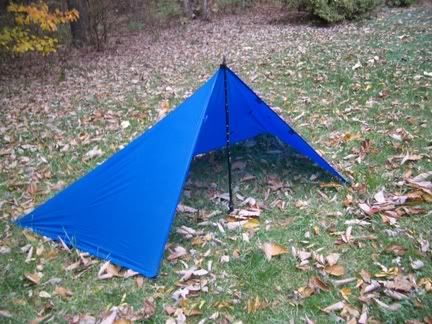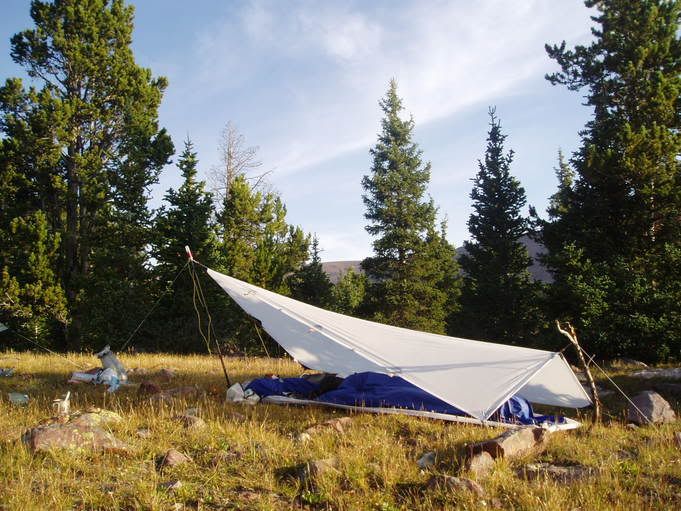Topic
tarp tips
Forum Posting
A Membership is required to post in the forums. Login or become a member to post in the member forums!
Home › Forums › General Forums › General Lightweight Backpacking Discussion › tarp tips
- This topic is empty.
-
AuthorPosts
-
Jan 13, 2006 at 12:45 pm #1217535
Ok boys I am about to take the plunge and switch from a tent to a tarp/bivy combo. My nano tarp shipped on tuesday and should be waiting for me when I get home. I have the BMW bivy. I live in Atlanta and hike in North Ga, Tenn and N carolina. I do not venture out in ice and snow because you cannot safely get to and from the trailhead when that happens down here. I am looking for tarp/bivy tips from people who really use this for their shelter espically those who successfully tarp in the rain.
Jan 13, 2006 at 2:27 pm #1348496I have been using a golite poncho tarp and equinox bivy combo for about six months now, I have used them in temperatures ranging from 60 degrees to 10. I personaly like a lean to formation more than the A frame in my oware cat tarp because it is easier to get into and out of, but if I expect colder weather or heavy rain I will set up my tarp in an A frame, for heat retention an more rain protection. As for the equinox bivy, I like it for the fall and winter, but in the summer, without bug netting it is horible, I woke up on several occations finding bugs and spiders in my hood, I am going to replace it with a bug net and ground cloth for three season, this set up has more ventillatin and is lighter too but will bring the bivy in the winter, but of course with the BMW bivy you dont have this problem. Also I am moving twords UL hammock camping leaving my 3.5lb load behind for a 5. But with a diagonal ridgeline, my poncho has enough coverage and only needs two stakes. You may consider buying a travel hammock or making a silk hammock, that is my next project after recently modifying my eagles nest to reduce the weight by 50%, even when hammock camping I am weight obsessive :-)
I dont know if I gave any real advice, but I do recomend getting either a poncho tarp or flat tarp, they are more versatile to set up and can be easier to get into your sleeping bag if set up in a lean to
here are a few of my favorite set ups
one of my golite poncho tarp and the other of RJs tarp, but I use it most often when tarp camping, it may be my favorite pitch


I like the first set up becaue it only needs one guy line, and I have even been able to angle the trekking pole in such a way where no guy lines were needed. who else has ever heard of a guy line less tarp?
I usually bring two 8 foot guy lines, so I can set up the two above set ups, a traditonal lean to, or if needed, an A frame with the sides staked to the ground
Jan 13, 2006 at 3:48 pm #1348509Sunny,
Tarping in the rain is the best as far as I am concerned. I was on the AT in ’03. If you were in Atlanta then, you will remember that it rained for a couple of months straight, from early April through May. Even the ridge tops were flooded. The tarp did just fine. It was a tapered 8X10, not the little catenary tarp you are using, but it had two occupants. Tents went down but the tarp stayed up and dry, and we invited tent campers under the tarp so they could cook, warm up and dry out.A bivy is a good combination with a small tarp. It is real easy to slide out from under the tarp… especially when the bivy or groundsheet is made with slippery ultralight material.
Bug protection is always an issue when it warms up a little in the South, so you might want to look at some of the other threads in BPL forums to see how folks handle that.
When not in a hammock, I often use a small tarp about the same size as the catenary nanotarpwith bug net attached to the perimeter or a poncho. The poncho gets set up much like Ryan’s photo — a sort of pyramid — if I expect any rain or blow. A leanto catches too much wind. With the catenary tarp, I set up with the upwind side staked to or almost to the ground or with the foot to the wind set as low as it will go and the rear sides staked to the ground. Either way limits the inside space, but has proved adequate with a bivy. The only wet you will get is some wind-blown spray and splash. You can avoid even that with a larger tarp and go without the bivy, but the small tarp/bivy combo is hard to beat for versatiliy.
The main thing is site selection. Look for raised ground where water will not pool, thick forest duff/needles/leaves
to absorb runoff, as much wind protection as possible, no widow makers waiting in surrounding trees.If you set up just right, you can catch enough water in pots, cups, or plastic bags that you won’t have to make water runs.
Jan 13, 2006 at 3:48 pm #1348510.
Jan 13, 2006 at 7:15 pm #1348525Practice!
Every chance you get, try to pitch your tarp. In the park, in your yard. Try to pitch it in a different place and a different way every day.
When you start getting bored with this, add to the difficulty by practicing in the dark. Then practice while slightly intoxicated. Then when you are very intoxicated. Then have a friend spray you with a garden hose while you pitch the tarp.
All of these advanced training tips are both very fun and accurately simulate actual trail conditions. Think about pitching your tarp in a storm while mildly hypothermic at the end of a wicked hard day.
Jan 13, 2006 at 7:22 pm #1348528Nice tip David,
That is another reason I favor flat tarps over cat tarps, many setups only need 2 guylines, this is alot easier than messing with 6 or 8 slippery spectra cords in the middle of the night with nothing but a mini photon light to guide you :-)
Jan 13, 2006 at 7:32 pm #1348529Good tips from the others. Another thing to think about is guyline management. It can be a pain at the beginning to have all these strings hanging around and getting in the way. I’d recommend taking a line, folding it in half, half again, half again [etc], then tie it in a loose overhand knot. That way you have a nice guyline bundle at each tie-out instead of a tangly mess. Stakes and lines should be your friends.
A bonus is that practically everywhere down South is below treeline, so it’s not hard to find a protected area near an old hemlock or a laurel thicket.
-Mark [in Alpharetta]
Jan 14, 2006 at 4:18 am #1348556Anonymous
GuestDavid, that method is known as the Bode Miller technique of shelter erection.
Posted: 01/13/2006 20:15:05 MST by David Bonn (david_bonn)
“practice while slightly intoxicated.”
-
AuthorPosts
- You must be logged in to reply to this topic.
Forum Posting
A Membership is required to post in the forums. Login or become a member to post in the member forums!
HAPPENING RIGHT NOW (February 11-21, 2025) - Shop Hyperlite Mountain Gear's Biggest Sale of the Year:
Our Community Posts are Moderated
Backpacking Light community posts are moderated and here to foster helpful and positive discussions about lightweight backpacking. Please be mindful of our values and boundaries and review our Community Guidelines prior to posting.
Get the Newsletter
Gear Research & Discovery Tools
- Browse our curated Gear Shop
- See the latest Gear Deals and Sales
- Our Recommendations
- Search for Gear on Sale with the Gear Finder
- Used Gear Swap
- Member Gear Reviews and BPL Gear Review Articles
- Browse by Gear Type or Brand.





